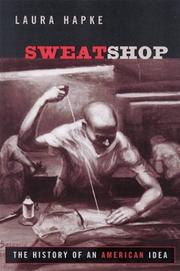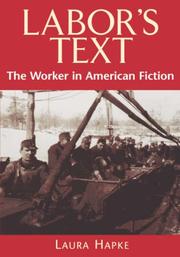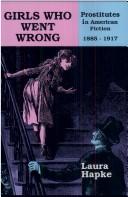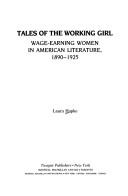| Listing 1 - 7 of 7 |
Sort by
|
Book
ISBN: 0820317187 Year: 1995 Publisher: Athens London University of Georgia Press
Abstract | Keywords | Export | Availability | Bookmark
 Loading...
Loading...Choose an application
- Reference Manager
- EndNote
- RefWorks (Direct export to RefWorks)
Crises (Economie) in de literatuur --- Crises économiques dans la littérature --- Depressions in literature --- Travail dans la littérature --- Werk in de literatuur --- Women employees in literature --- Work in literature --- American fiction --- Women --- Women and literature --- Roman américain --- Femmes --- Femmes et littérature --- Personnel féminin dans la littérature --- Women authors --- History and criticism --- Employment --- Historiography --- History --- Femmes écrivains --- Histoire et critique --- Travail --- Historiographie --- Histoire --- Roman américain --- Femmes et littérature --- Personnel féminin dans la littérature --- Travail dans la littérature --- Femmes écrivains --- 20th century --- United States

ISBN: 0813534666 9786613904478 0813542561 1283592029 081353710X 9780813537108 9780813534664 0813534674 9780813534671 9780813542560 9781283592024 6613904473 Year: 2004 Publisher: New Brunswick, NJ
Abstract | Keywords | Export | Availability | Bookmark
 Loading...
Loading...Choose an application
- Reference Manager
- EndNote
- RefWorks (Direct export to RefWorks)
Arguing that the sweatshop is as American as apple pie, Laura Hapke surveys over a century and a half of the language, verbal and pictorial, in which the sweatshop has been imagined and its stories told. Not seeking a formal definition of the sort that policymakers are concerned with, nor intending to provide a strict historical chronology, this unique book shows, rather, how the “real” sweatshop has become intertwined with the “invented” sweatshop of our national imagination, and how this mixture of rhetoric and myth has endowed American sweatshops with rich and complex cultural meaning. Hapke uncovers a wide variety of tales and images that writers, artists, social scientists, reformers, and workers themselves have told about “the shop.” Adding an important perspective to historical and economic approaches, Sweatshop draws on sources from antebellum journalism, Progressive era surveys, modern movies, and anti-sweatshop websites. Illustrated chapters detail how the shop has been a facilitator of assimilation, a promoter of upward mobility, the epitome of exploitation, a site of ethnic memory, a venue for political protest, and an expression of twentieth-century managerial narratives. An important contribution to the real and imagined history of garment industry exploitation, this book provides a valuable new context for understanding contemporary sweatshops that now represent the worst expression of an unregulated global economy.
Sweatshops -- United States -- History. --- Sweatshops --- History. --- Sweat shops --- Sweated industries --- Sweating system --- Factories --- Anti-sweatshop movement --- History --- E-books

ISBN: 0813528801 9780813528809 Year: 2001 Publisher: New Brunswick, New Jersey Rutgers University Press
Abstract | Keywords | Export | Availability | Bookmark
 Loading...
Loading...Choose an application
- Reference Manager
- EndNote
- RefWorks (Direct export to RefWorks)
American fiction --- Labor movement in literature. --- Work in literature. --- Working class in literature. --- Working class writings, American --- Working class --- History and criticism. --- Intellectual life --- Work in literature --- Labor movement in literature --- Working class in literature --- Labor and laboring classes in literature --- Commons (Social order) --- Labor and laboring classes --- Laboring class --- Labouring class --- Working classes --- Social classes --- Labor --- History and criticism --- Employment
Book
ISBN: 1282192140 9786612192142 1443808512 9781443808514 1847184154 9781847184153 9781282192140 6612192143 Year: 2008 Publisher: Newcastle, UK : Cambridge Scholars Pub.,
Abstract | Keywords | Export | Availability | Bookmark
 Loading...
Loading...Choose an application
- Reference Manager
- EndNote
- RefWorks (Direct export to RefWorks)
Working class in art. --- Art, American --- Working class --- Commons (Social order) --- Labor and laboring classes --- Laboring class --- Labouring class --- Working classes --- Social classes --- Labor --- Art, Modern --- Chicago Imagists (Group of artists) --- Figuration libre (Group of artists) --- Fort Worth Circle (Group of artists) --- Hairy Who (Group of artists) --- Monster Roster (Group of artists) --- Philadelphia Ten (Group of artists) --- Pictures Generation (Group of artists) --- Labor and laboring classes in art --- Social conditions. --- Employment --- Federal Art Project --- United States. --- Federal Art Project (U.S.) --- History.

ISBN: 0879724749 Year: 1989 Publisher: Bowling Green, Ohio Bowling Green State University Popular Press
Abstract | Keywords | Export | Availability | Bookmark
 Loading...
Loading...Choose an application
- Reference Manager
- EndNote
- RefWorks (Direct export to RefWorks)

ISBN: 0805788557 Year: 1992 Publisher: New York Toronto New York Twayne Publishers Maxwell Macmillan Canada Maxwell Macmillan International
Abstract | Keywords | Export | Availability | Bookmark
 Loading...
Loading...Choose an application
- Reference Manager
- EndNote
- RefWorks (Direct export to RefWorks)
Book
ISBN: 1282035568 1443803960 9786612035562 9781443803960 9781443801058 1443801054 9781282035560 Year: 2008 Publisher: Newcastle upon Tyne, U.K. : Cambridge Scholars Pub.,
Abstract | Keywords | Export | Availability | Bookmark
 Loading...
Loading...Choose an application
- Reference Manager
- EndNote
- RefWorks (Direct export to RefWorks)
A Class of Its Own positions important and rediscovered American social protest authors Otherin both a scholarly and student-centered context. The volume draws on the expertise and pedagogy of established and younger scholars who move gracefully from theories of what makes a text "working class" to how studies of class empower college teachers and courses. Among the authors discussed in the volume's essays and prominent in the book's syllabi section are Zora Neale Hurston, Stephen Crane, Agnes...
| Listing 1 - 7 of 7 |
Sort by
|

 Search
Search Feedback
Feedback About UniCat
About UniCat  Help
Help News
News